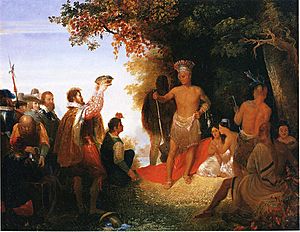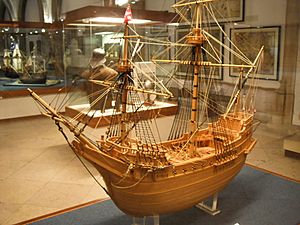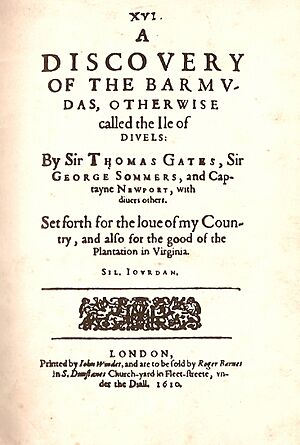Christopher Newport facts for kids
Quick facts for kids
Christopher Newport
|
|
|---|---|

Statue of Christopher Newport on the campus at Christopher Newport University depicts him with both arms, prior to the loss of one arm in the Anglo-Spanish War. Monumental Sculpture by Jon Hair
|
|
| Born | December, 1561 Limehouse, London, England |
| Died | August 1617 (aged 55) Bantam, Java |
| Rank | Vice Admiral |
| Commands held | Little John (1590), Golden Dragon (1592), Susan Constant (1607), John and Francis (1608), Mary and Margaret (1608), Prosperous (1611), Expedition (1613) |
| Spouse(s) | Katherine Proctor (1584-1590) Ellen Ade (1590) Elizabeth Glanville (1595-?) |
Christopher Newport (1561–1617) was an English sailor and explorer. He is famous for leading the ships that carried the first English settlers to Jamestown in 1607. This settlement became the first permanent English colony in North America.
Newport was the captain of the Susan Constant, the largest of the three ships that sailed to Virginia. He was also in charge of the other two ships, the Godspeed and the Discovery. Before this historic voyage, Newport was known as a successful privateer during the war between England and Spain. A privateer was a sailor who was allowed by their government to attack and capture enemy ships.
He made several important trips between England and Jamestown, bringing much-needed supplies to the new colony. In 1609, his ship, the Sea Venture, was caught in a hurricane and shipwrecked on the islands of Bermuda.
Contents
Early Life and Adventures at Sea
Christopher Newport was born in December 1561 in Limehouse, a busy port city on the River Thames in England. His father was also a shipmaster, meaning he commanded trading ships. Christopher followed in his father's footsteps, going to sea around 1580. He quickly became a skilled master mariner, involved in trade routes to London. In 1584, he married Katherine Proctor.
A Privateer's Life
Starting in 1585, during the war between England and Spain, Newport became a privateer. This meant he commanded ships that raided Spanish trading vessels, mostly in the Caribbean Sea. He sailed on several privateer ships, including the Little John and the Golden Dragon. In 1590, during an expedition to the Caribbean, Newport bravely fought to capture a Spanish ship. Sadly, he lost an arm during this battle.
Even with his injury, Newport continued his adventures for nearly twenty more years. He was very successful, capturing many valuable treasures from Spanish ships. For example, in 1592, he helped capture a Portuguese ship called the Madre de Deus. This ship carried an enormous amount of spices, silks, jewels, and other riches, making it one of the biggest captures of its time. Newport even sailed with the famous explorer Francis Drake on a raid against Cadiz, Spain.
After the war ended in 1604, Newport continued his travels. In 1605, he returned to England from the Caribbean with two baby crocodiles and a wild boar. He presented these exotic animals as gifts to King James I, who loved unusual creatures.
Founding Jamestown
Christopher Newport's vast experience and excellent reputation led the Virginia Company of London to hire him in 1606. This company had permission from King James I to start a new English settlement in what is now Virginia. Newport was chosen to command the Susan Constant, which carried 71 male colonists, including the famous John Smith.
When the ships reached the coast of North America, sealed orders were opened. These orders named Newport as a member of the governing Council for the new colony. On April 29, 1607, Newport placed a cross at the entrance of the bay, claiming the land for England. They named this spot Cape Henry. Over the next few days, the ships sailed up the James River to find the perfect place for their settlement. They chose a spot and named it Jamestown.
First and Second Supply Missions
In June 1607, just a week after the first fort at Jamestown was finished, Newport sailed back to London. He left behind 104 colonists and the small ship Discovery for their use. The colonists faced many challenges, including a harsh winter where many sadly passed away. They desperately needed supplies.
Newport returned to Jamestown twice in the next 18 months, leading what were called the First and Second Supply missions. These missions brought essential food, tools, and more people to the struggling colony.

The First Supply arrived in January 1608 with two ships, the John and Francis and the Phoenix. They brought 120 new settlers, increasing the colony's population. Newport quickly returned to England for even more supplies. On this trip, he took a Native American man named Namontack from the Powhatan tribe to London. Namontack stayed for three months before returning to Virginia with Newport.
The Second Supply arrived in September 1608, with Newport commanding the Mary Margaret. This mission brought 70 more people, including the first two English women to arrive in the colony. The Virginia Company also asked Newport to try and make friends with the powerful Native American chief Powhatan. They even wanted to "crown" him as an English ally. However, Powhatan considered himself a king already and refused to kneel for the crown.
The Ill-Fated Sea Venture and the Third Supply
In June 1609, Newport set out on his third major voyage to America. He was the captain of the Sea Venture, the brand-new flagship for the Third Supply mission. This fleet of nine ships aimed to bring many more settlers and supplies to Jamestown.
However, a massive hurricane struck the fleet on July 24. The ships were separated, and the Sea Venture began to leak badly. To save everyone on board, Admiral Sir George Somers bravely steered the ship onto a reef near Bermuda. All 150 colonists and crew members survived the shipwreck!
They spent ten months on Bermuda, building two smaller ships, the Deliverance and the Patience, from the wreckage and local cedar wood. When they finally reached Jamestown in May 1610, they found the colony in terrible shape. Many colonists had passed away during a very difficult period known as the Starving Time. With so few supplies left, Newport and the others felt they had no choice but to abandon Jamestown.
On June 7, they boarded their ships and started to sail away. But as they sailed downriver, they met a "fourth" supply mission led by a new governor, Thomas West. He ordered everyone to return to Jamestown, and the colony was saved.
On his last trip to Jamestown in 1610, Newport brought John Rolfe. Rolfe later developed a new type of tobacco that became very important for the colony's success.
Later Voyages and Passing
Newport made his final trip to Jamestown in May 1611, leaving in August. In 1612, he joined the English East India Company, a powerful trading company. He commanded several voyages to the Far East and India. In November 1616, he wrote his will and began his third voyage to the East Indies, this time with his son, also named Christopher. He passed away in Java (now part of Indonesia) sometime after August 15, 1617, from unknown causes.
Impact
Christopher Newport was a pivotal figure in the early years of the Jamestown colony, and his impact was both profound and multifaceted. He was the right man for the initial phase of the colony: a skilled mariner, a determined leader, and a capable diplomat for first contact. He was the literal lifeline that kept Jamestown from vanishing in its first two years.
However, his actions, often driven by the misguided profit-motives of the Virginia Company, also planted the seeds for future conflict. His focus on finding riches and his clumsy diplomacy exacerbated tensions with the Powhatan Confederacy, a problem that would escalate into years of warfare after his final departure.
Legacy
- Newport, Kentucky, in the US, was named in his honor.
- Newport News Point and the city of Newport News, Virginia in the US, are thought to be named after him. However, this is debated.
- Christopher Newport University, in Newport News, Virginia, is named after him.
- The World War II Liberty Ship SS Christopher Newport was named in his honor.
- Captain Newport has been played by actors in movies. David Hemblen played him in Pocahontas: The Legend (1999). Christopher Plummer played him in Terrence Malick's 2005 film The New World. He did not appear in the 1995 Disney animated film or its 1998 direct-to-video sequel. In the Disney films, his role is replaced by the bad guy, Governor Ratcliffe.
See also
 In Spanish: Christopher Newport para niños
In Spanish: Christopher Newport para niños



